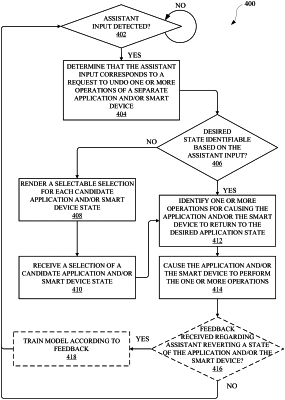| CPC G06F 3/04842 (2013.01) [G06F 3/016 (2013.01); G06F 3/0481 (2013.01); G06F 3/167 (2013.01); G10L 15/22 (2013.01); G10L 2015/223 (2013.01)] | 14 Claims |

|
1. A method implemented by one or more processors, the method comprising:
receiving, by a computing device, an assistant input that is provided by a user to an automated assistant that is accessible via the computing device;
determining, by the automated assistant, that the assistant input corresponds to a request to undo certain operations performed by at least one smart device that is associated with an application that is separate from the automated assistant,
wherein the request to undo the certain operations performed by the at least one smart device that is associated with the application does not identify the certain operations;
identifying, based on the assistant input, one or more operations that have affected a state of the at least one smart device that is associated with the application;
wherein the one or more operations caused the at least one smart device to transition from a first smart device state to a second smart device state that differs from the first smart device state,
wherein the user provided the assistant input during, or subsequent to, the at least one smart device exhibiting the second smart device state, and
identifying, by the automated assistant, one or more other operations to cause the at least one smart device to transition from the second smart device state and back to the first smart device state,
wherein identifying the one or more other operations to cause the at least one smart device to transition from the second smart device state and back to the first smart device state comprises:
processing, using a trained machine learning model that is trained based on prior instances in which the user or another user caused the at least one smart device associated with the application to revert to a particular operating state, application data and log data for the application that is associated with the at least one smart device to generate output,
wherein the application data characterizes a plurality of operations that are capable of being performed by the at least one smart device or the application that is associated with the at least one smart device, and
wherein the log data characterizes the one or more operations that have affected the state of the at least one smart device that is associated with the application; and
determining, based on the output, whether the one or more other operations to cause the at least one smart device to transition from the second smart device state and back to the first smart device state are identifiable;
in response to determining that the one or more other operations to cause the at least one smart device to transition from the second smart device state and back to the first smart device state are identifiable:
identifying, based on the output, the one or more other operations to cause the at least one smart device to transition from the second smart device state and back to the first smart device state;
in response to determining that the one or more other operations to cause the at least one smart device to transition from the second smart device state and back to the first smart device state are not identifiable:
causing a selection prompt to be rendered for presentation to the user, wherein the selection prompt includes at least a first selectable option that identifies the first smart device state and a second selectable option that identifies the second smart device state,
receiving a user selection of the first selectable option in response to the selection prompt being rendered for the user; and
identifying, based on the user selection, the one or more other operations to cause the at least one smart device to transition from the second smart device state and back to the first smart device state; and
causing, based on the assistant input and based on the one or more other operations, the at least one smart device to revert from the second smart device state and back to the first smart device state.
|